The Basics on Puget Sound Searun Cutthroat Fly Fishing
Searun Cutthroat fly fishing throughout Puget Sound and the surrounding Seattle vicinity is undoubtedly one of the best year round fly fishing options anglers have in the Pacific Northwest. Twelve months of the year this fishery sustains an ecosystem where anglers can test their skills tossing intermediate lines, streamers and fast action rods to power through often prevalent Puget Sound winds. This is an intermediate to advanced casters realm though, as the ability to double haul and throw 30+ ft. casts can directly correlate to an increase in an anglers success – the better caster you are – the more success you will most likely have. This isn’t always the case though, especially if you have fish located close to shore – which they often are. A beginning caster can find success in these situations.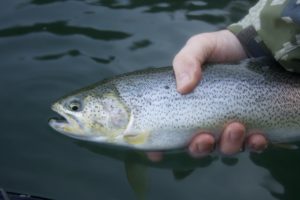
Boat fishing for Searun Cutthroat in Puget Sound opens endless doors and beach options to the adventurous angler. Rather than being confined to a small piece of public beach, park or other public access area, anglers have the freedom to explore – at will – the many productive Puget Sound Searun Cutthroat beaches. Check out some of my past blog articles for tips on what to look for in a productive Searun Cutthroat beaches.
If you can reach Puget Sound Searun Cutthroat with your cast and fly, they aren’t overly picky – as they willingly will gobble down a variety of patterns. That’s what makes this fishery so cool, hard fighting and aggressive Puget Sound Searun Cutthroat that rarely turn down a baitfish pattern or other tasty looking treat.
Puget Sound Searun Cutthroat roam over 2000+ miles of shoreline encompassing Puget Sound, Hood Canal and the Strait of Juan De Fuca. Who could ask for more space than that to wet a line. Rarely, do I see
any competition on the beaches I guide clients on – creating a unique, peaceful and quality experience that is all too hard to come by these days.
Where to begin as a new angler Fly Fishing for Puget Sound Searun Cutthroat?
Big, broad and intimidating are just a few words that anglers use to describe our Puget Sound Searun Cutthroat fishery( just check out the map to the right – it’s a big area). I grew up on the waters of Puget Sound fly fishing for Searun Cutthroat and looked out my front window daily to the home waters I was going to fish, and therefore this is what I became used to seeing. If I was raised on rivers and streams those would be just as familiar as the massive 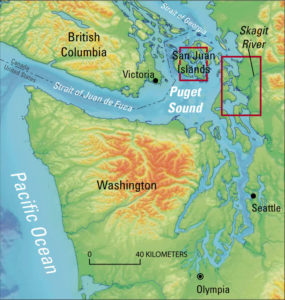 Puget Sound may seem to some new anglers. To a new angler who is used to fishing rivers, lakes and streams in a much smaller ecosystem it can be overwhelming. So, my first recommendation is to hire a Puget Sound Cutthroat Guide.
Puget Sound may seem to some new anglers. To a new angler who is used to fishing rivers, lakes and streams in a much smaller ecosystem it can be overwhelming. So, my first recommendation is to hire a Puget Sound Cutthroat Guide.
A Puget Sound Searun Cutthroat guide can cut the learning curve by years of trial and error of doing it yourself. Puget Sound Searun Cutthroat fishing is very unique in the fact that a traveling angler can’t as easily transition their stream, lake and river mindset right into this fishery. Of course, good casting skills, attention to detail and all the other attributes of a successful angler apply, but we aren’t looking for riffles, runs and pools in this fishery ladies and gentlemen. Identifying those fishy looking beaches comes through trial and error – painstakingly at times – but the rewards can be all to gratifying once the mystery of unlocking where and how Puget Sound Searun Cutthroat travel, and why they show up on certain beaches on certain tides is de-mystified.
Factors to consider when fly fishing for Puget Sound Searun Cutthroat include tides, the solular theory, weather, water temperature, available food sources, choosing a good beach and how to identify what a good beach is, and having the specific tackle and flies that will make your day go smoothly. Let’s break these categories down now.
Tides – Tides are the rise and fall of sea levels caused by the combined effects of the gravitational forces exerted by the Moon and the Sun and the rotation of the Earth. There are two high tides and two low tides during each 24 hour day based around a 6 hour cycle on each tide, therefore making up a total of 24 hours. Puget Sound Searun Cutthroat will having peak feeding activity based around certain cycles of a tide (see solar theory in next bullet item). The best way to learn when they are active and when certain beaches fish well is through experience and time on the water. When choosing the best time to pursue Puget Sound Searun Cutthroat I look for big tide swings with lots of tidal movement. Moving current makes fish more active and it provides a food source for them – very similar to a river or stream. If you can combine a good moving tide with the the first and last hour of daylight (in combination with a good solunar rating) you’re in business with a winning combination.
Solunar Theory – What the heck is that you say? Well, some savvy anglers have been using this as a reference to good fishing for a long time. This is the relationship to the sun and the moon, throughout a tide cycle that can produce good fishing. Guess what, it does work! When guiding clients for a day of fly fishing, this isn’t the only factor I take into play. I also consider tides, and base my departure time off the tides and then look at the minor and major fishing times within the time frame that I will be on the water. Check out solunarforecast.com to figure out the best fishing times for Puget Sound and Hood Canal Sea-Run Cutthroat – make sure to pay attention to the major and minor fishing times.
Weather – consider weather conditions for the day. Will it be rainy or bright and sunny out? Bright, sunny 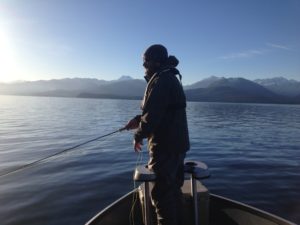 conditions will sometimes drive the fish deeper into the water column, where a faster sinking line will be a necessity.
conditions will sometimes drive the fish deeper into the water column, where a faster sinking line will be a necessity.
Low light and rainy conditions on the other hand might demand a floating line or intermediate tipped line. My ideal year round line is the Rio Coastal Quickshooter in full intermediate. If conditions warrant different lines, I keep pre-rigged rods ready to go or additional reels/spools with those lines available.
Identifying a good beach – Look for the beach quadfecta as I like to call it. This consists of a point of land, a decent pitch to the beach, structure on the bottom and moving current. Generally speaking, if you find those factors or a combination of most of those factors you will find fish in the vicinity. Points of land with a deep water drop (beach slope) offer protection from predators, and natural gathering points for baitfish and other food sources for Puget Sound Searun Cutthroat. Current that is moving by that point of land is another win-win, as it brings that food source to the fish staging on or around that point. Searun Cutthroat will use the bottom structure such as rocks, boulders and oysters to ambush prey, particularly with a good moving current. The beach quadfecta serves as a good starting point on what to look for, but certainly is not where the fish are always at. Puget Sound Searun Cutthroat move around a fair amount and will inhabit many different types of beach structure – sometimes in areas that don’t look like cutthroat magnets at all. When I arrive to a beach, I fish it twenty-five minutes and if I haven’t hooked a fish or seen activity such as fish jumping or chasing baitfish I move on to the next spot.
Water Temperature – Generally speaking, the water temperatures throughout Puget Sound and Hood Canal stay 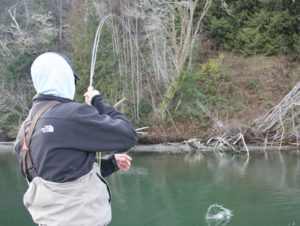
fairly consistent(48-54 degrees Farenheit) with the exception of the southerly reaches of both areas. Hood Canal last summer got extremely warm in the southern part of the fjord and this can effect fish. They will look to escape the warm temperatures by heading deeper into the water column or going on a “walk about” and traveling to find that cool water. If you are fishing in warm water conditions, focus on fishing beaches with deep water drop offs in close proximity which will offer cooler water temperatures. Water temperatures into the mid-60’s can start to negatively effect Puget Sound Searun Cutthroat while catching and releasing, so if this is the case move on to some cooler water areas.
Tackle – One of the best parts of this fishery, is that anglers can simply transition their lake and river gear right over into fly fishing for Puget Sound Searun Cutthroat. I do fish specific fast action and medium/fast actions rods for this fishery, but you don’t have to just starting out. Here’s a basic list of what you’ll need to get started:
- Rod – 5 or 6 weight, 9 foot rod ideally medium/fast or fast action to power through windy conditions at times. i use Sage Salt 590, 690 and Sage Motive 690 models. Start out using what you have available, and you can always upgrade later on. Beach Rods – If you are fishing from the beach specifically, then a 9’6″ or even 10′ rod in a 6-weight is a good option as it will give you that extra casting distance a little easier. A 6 weight also doubles as a good resident and migratory coho rod.
- Reel – ideally a saltwater specific reel with a sealed drag system, but your freshwater trout gear set up will work. I Prefer
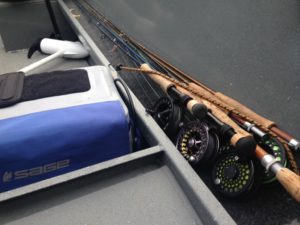 Sage 3200 series reels.
Sage 3200 series reels. - Lines – now were talking one of the most important items of your tackle outlay! I prefer a full intermediate line due to the fact that is sinks consistently and does not have any hinging effect like a sink tip line. This gives a direct one to one connection between you and the fish. Rio’s Coastal Quickshooter is newly redesigned this year, and is by far my favorite line. It has a clear 30 ft. intermediate head with a bright high vis yellow running line which is makes it easy to see clients lines while guiding Puget Sound Searun Cutthroat trips.
- Stripping Basket – if you are fishing from the beach with an intermediate or any other type of sinking line, this is a must have. A stripping basket keeps the line out of the rocks and allows you to shoot your line much further. These can be purchased for around 50-70 bucks, or you can make your own. Just do a search on youtube for fly fishing stripping baskets – they are easy to make.
- Rinse your gear – Made for saltwater or not, rinsing your gear off with the hose after each trip will keep them in good shape. Don’t forget to detach your spool from your reel to allow it to dry out. I also rinse my waders, jacket and anything else I don’t want to corrode from saltwater after each trip. Occasionally, add a small of reel oil in the working parts, particularly if it is not a sealed drag system.
Ok, so now you’ve got an idea of some things to get you started as a Searun Cutthroat angler. Another nugget of information is to figure out your game plan (beach plan) for each day fishing. Do your research mapping out beaches you would like to fish, then visit those beaches and start fishing – keeping in mind to log weather, time of day, tides, solar theory, and beach structure. Your beach log will serve as a good reference for future trips back to those beaches and you can draw on your past experiences.
Keep moving beaches until you locate fish, and if you don’t I’m sure you’ll enjoy your day on the water taking in the wildlife and natural beauty of the Puget Sound, Hood Canal and Strait of Juan De Fuca regions.
